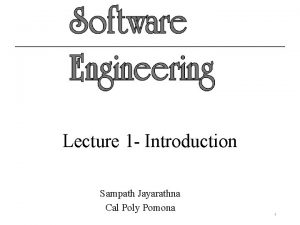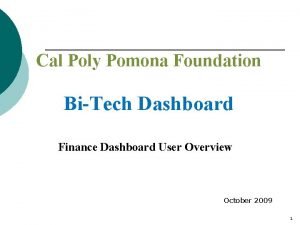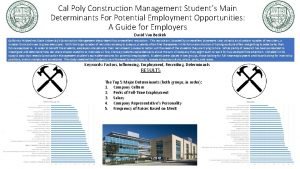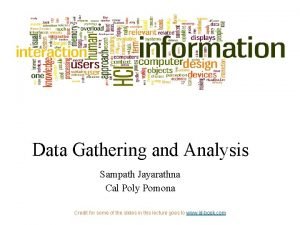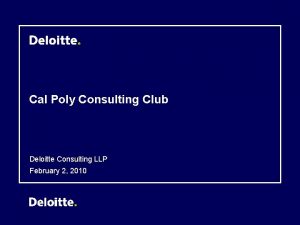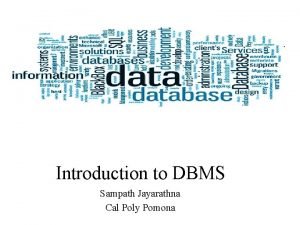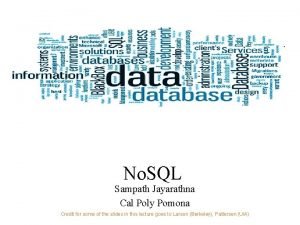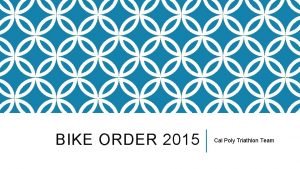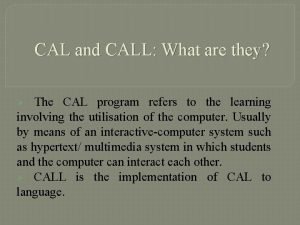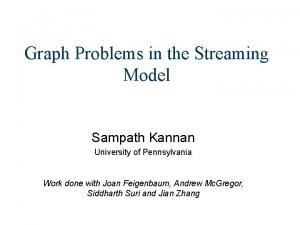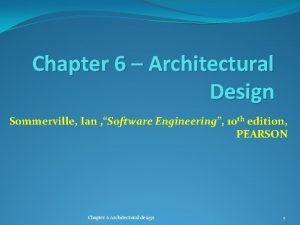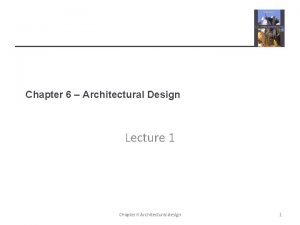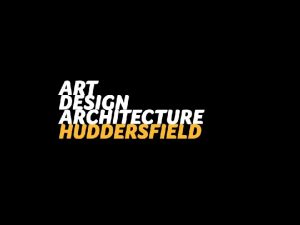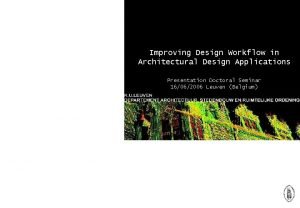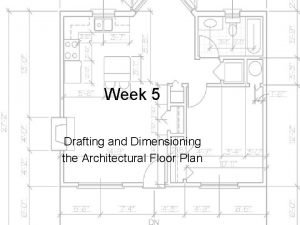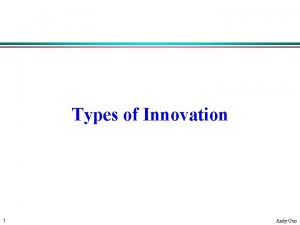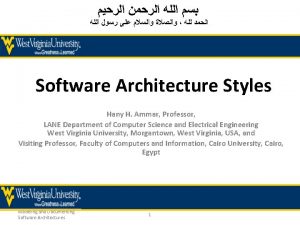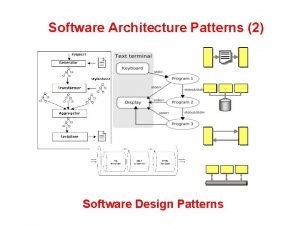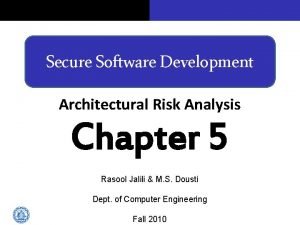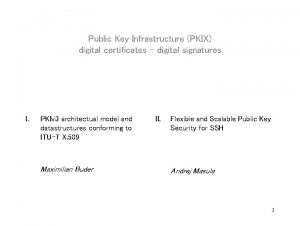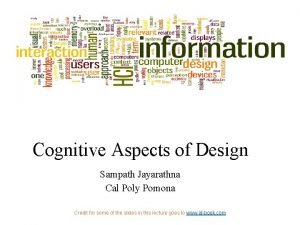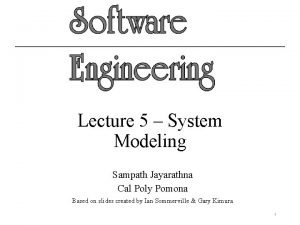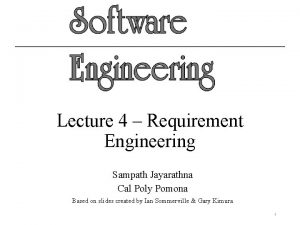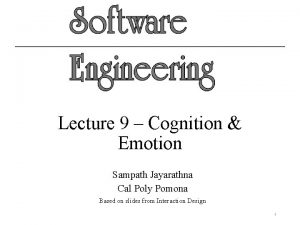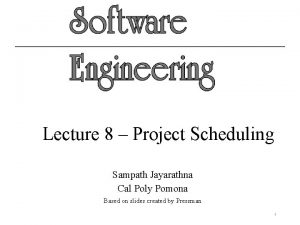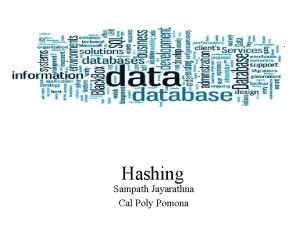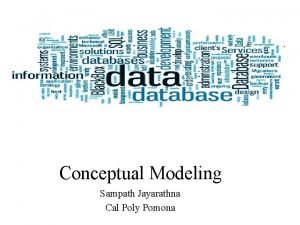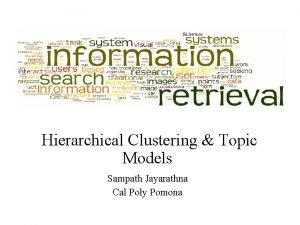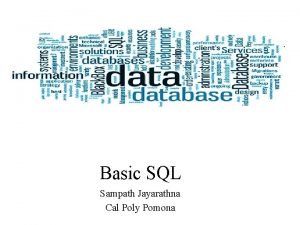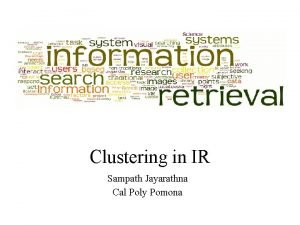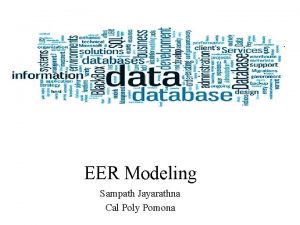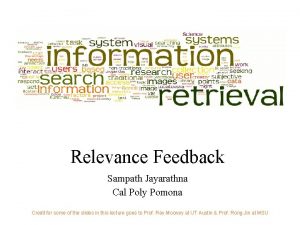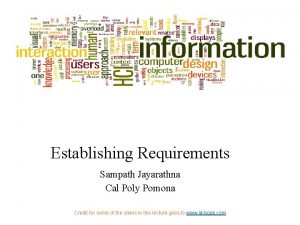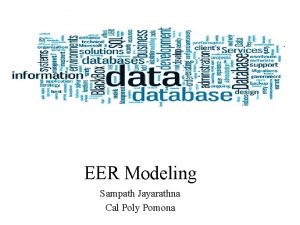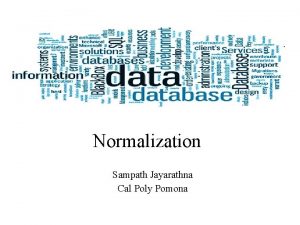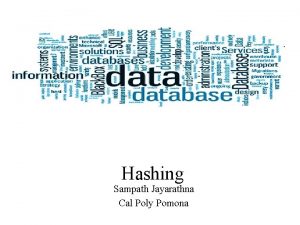Lecture 6 Architectural Design Sampath Jayarathna Cal Poly













































- Slides: 45

Lecture 6 – Architectural Design Sampath Jayarathna Cal Poly Pomona Based on slides created by Ian Sommerville & Gary Kimura 1

Topics covered • Architectural design decisions • Architectural views • Architectural patterns • Application architectures

Architectural design • The software architecture of a program or computing system is the structure or structures of the system which comprise • The software components • The externally visible properties of those components • The relationships among the components • Software architectural design represents the structure of the data and program components that are required to build a computer-based system • Critical link between design and requirement engineering • An architectural design model is transferable • It can be applied to the design of other systems • It represents a set of abstractions that enable software engineers to describe architecture in predictable ways

Agility and architecture • It is generally accepted that an early stage of agile processes is to design an overall systems architecture. • Refactoring the system architecture is usually expensive because it affects so many components in the system

Architectural Design Process • Basic Steps • Creation of the data design • Derivation of one or more representations of the architectural structure of the system • Analysis of alternative architectural styles to choose the one best suited to customer requirements and quality attributes • Elaboration of the architecture based on the selected architectural style • A database designer creates the data architecture for a system to represent the data components • A system architect selects an appropriate architectural style derived during system engineering and software requirements analysis 5

Box and line diagrams • Very abstract - they do not show the nature of component relationships nor the externally visible properties of the subsystems. • However, useful for communication with stakeholders and for project planning.

Example Software Architecture Diagrams 7

Advantages of explicit architecture • Stakeholder communication • Architecture may be used as a focus of discussion by system stakeholders. • System analysis • Means that analysis of whether the system can meet its non-functional requirements is possible. • Large-scale reuse • The architecture may be reusable across a range of systems • Product-line architectures may be developed.

Purpose of Data Design • Data design translates data objects defined as part of the analysis model into • Data structures at the software component level • A possible database architecture at the application level • It focuses on the representation of data structures that are directly accessed by one or more software components • The challenge is to store and retrieve the data in such way that useful information can be extracted from the data environment 9

Architecture reuse • Systems in the same domain often have similar architectures that reflect domain concepts. • Application product lines are built around a core architecture with variants that satisfy particular customer requirements. • The architecture of a system may be designed around one of more architectural patterns or ‘styles’. • These capture the essence of an architecture and can be instantiated in different ways.

Architectural views

4 + 1 view model of software architecture • A logical view, which shows the key abstractions in the system as objects or object classes. • A process view, which shows how, at run-time, the system is composed of interacting processes. • A development view, which shows how the software is decomposed for development. • A physical view, which shows the system hardware and how software components are distributed across the processors in the system. • Related using use cases or scenarios (+1)

Representing architectural views • Some people argue that the Unified Modeling Language (UML) is an appropriate notation for describing and documenting system architectures • UML does not includes abstractions appropriate for highlevel system description. • Architectural description languages (ADLs) have been developed but are not widely used

Architectural patterns • Patterns are a means of representing, sharing and reusing knowledge. • An architectural pattern is a stylized description of good design practice, which has been tried and tested in different environments. • Patterns should include information about when they are and when the are not useful. • Patterns may be represented using tabular and graphical descriptions.

A Taxonomy of Architectural Styles Independent Components Communicating Processes Client/Server Peer-to-Peer Data Flow Batch Sequential Implicit Invocation Explicit Invocation Data-Centered Pipe and Filter Virtual Machine Interpreter Event Systems Rule-Based System Repository Blackboard Call and Return Main Program and Subroutine Layered Object Oriented Remote Procedure Call 15

The organization of the Model-View. Controller

The Model-View-Controller (MVC) pattern Name MVC (Model-View-Controller) Description Separates presentation and interaction from the system data. The system is structured into three logical components that interact with each other. The Model component manages the system data and associated operations on that data. The View component defines and manages how the data is presented to the user. The Controller component manages user interaction (e. g. , key presses, mouse clicks, etc. ) and passes these interactions to the View and the Model. Example Next Figure shows the architecture of a web-based application system organized using the MVC pattern. Used when there are multiple ways to view and interact with data. Also used when the future requirements for interaction and presentation of data are unknown. Allows the data to change independently of its representation and vice versa. Supports presentation of the same data in different ways with changes made in one representation shown in all of them. Can involve additional code and code complexity when the data model and interactions are simple. When used Advantages Disadvantages

Web application architecture using the MVC pattern

Layered architecture • Used to model the interfacing of sub-systems. • Organises the system into a set of layers (or abstract machines) each of which provide a set of services. • Supports the incremental development of sub-systems in different layers. When a layer interface changes, only the adjacent layer is affected. • However, often artificial to structure systems in this way.

A generic layered architecture

The Layered architecture pattern Name Layered architecture Description Organizes the system into layers with related functionality associated with each layer. A layer provides services to the layer above it so the lowest-level layers represent core services that are likely to be used throughout the system. A layered model of a system for sharing copyright documents held in different libraries. Used when building new facilities on top of existing systems; when the development is spread across several teams with each team responsibility for a layer of functionality; when there is a requirement for multi-level security. Allows replacement of entire layers so long as the interface is maintained. Redundant facilities (e. g. , authentication) can be provided in each layer to increase the dependability of the system. In practice, providing a clean separation between layers is often difficult and a high-level layer may have to interact directly with lower-level layers rather than through the layer immediately below it. Performance can be a problem because of multiple levels of interpretation of a service request as it is processed at each layer. Example When used Advantages Disadvantages

Case Study: architecture of the i. Learn system

Repository (Data-Centered) architecture • Sub-systems must exchange data. This may be done in two ways: • Shared data is held in a central database or repository and may be accessed by all sub-systems; • Each sub-system maintains its own database and passes data explicitly to other sub-systems. • When large amounts of data are to be shared, the repository model of sharing is most commonly used a this is an efficient data sharing mechanism.

Data-Centered Style Client A Client B Client C Shared Data Client D Client E Client F 24

The Repository pattern Name Repository Description All data in a system is managed in a central repository that is accessible to all system components. Components do not interact directly, only through the repository. IDE where the components use a repository of system design information. Each software tool generates information which is then available for use by other tools. You should use this pattern when you have a system in which large volumes of information are generated that has to be stored for a long time. You may also use it in data-driven systems where the inclusion of data in the repository triggers an action or tool. Components can be independent—they do not need to know of the existence of other components. Changes made by one component can be propagated to all components. All data can be managed consistently (e. g. , backups done at the same time) as it is all in one place. The repository is a single point of failure so problems in the repository affect the whole system. May be inefficiencies in organizing all communication through the repository. Distributing the repository across several computers may be difficult. Example When used Advantages Disadvantages

A repository architecture for an IDE

Client-server architecture • Distributed system model which shows how data and processing is distributed across a range of components. • Can be implemented on a single computer. • Set of stand-alone servers which provide specific services such as printing, data management, etc. • Set of clients which call on these services. • Network which allows clients to access servers.

A client–server architecture for a film library

The Client–server pattern Name Client-server Description In a client–server architecture, the functionality of the system is organized into services, with each service delivered from a separate server. Clients are users of these services and access servers to make use of them. Next Figure is an example of a film and video/DVD library organized as a client–server system. Used when data in a shared database has to be accessed from a range of locations. Because servers can be replicated, may also be used when the load on a system is variable. The principal advantage of this model is that servers can be distributed across a network. General functionality (e. g. , a printing service) can be available to all clients and does not need to be implemented by all services. Each service is a single point of failure so susceptible to denial of service attacks or server failure. Performance may be unpredictable because it depends on the network as well as the system. May be management problems if servers are owned by different organizations. Example When used Advantages Disadvantages

Pipe and filter architecture • Functional transformations process their inputs to produce outputs. • Variants of this approach are very common. When transformations are sequential, this is a batch sequential model which is extensively used in data processing systems. • Not really suitable for interactive systems.

An example of the pipe and filter architecture used in a payments system

The pipe and filter pattern Name Pipe and filter Description The processing of the data in a system is organized so that each processing component (filter) is discrete and carries out one type of data transformation. The data flows (as in a pipe) from one component to another for processing. Next Figure is an example of a pipe and filter system used for processing invoices. Commonly used in data processing applications (both batch- and transaction-based) where inputs are processed in separate stages to generate related outputs. Easy to understand supports transformation reuse. Workflow style matches the structure of many business processes. Evolution by adding transformations is straightforward. Can be implemented as either a sequential or concurrent system. The format for data transfer has to be agreed upon between communicating transformations. Each transformation must parse its input and un-parse its output to the agreed form. This increases system overhead and may mean that it is impossible to reuse functional transformations that use incompatible data structures. Example When used Advantages Disadvantages

Application architectures • Application systems are designed to meet an organizational need. • As businesses have much in common, their application systems also tend to have a common architecture that reflects the application requirements. • A generic application architecture is an architecture for a type of software system that may be configured and adapted to create a system that meets specific requirements.

Use of application architectures • As a starting point for architectural design. • As a design checklist. • As a way of organizing the work of the development team. • As a means of assessing components for reuse. • As a vocabulary for talking about application types.

Examples of application types • Data processing applications • Data driven applications that process data in batches without explicit user intervention during the processing. • Transaction processing applications • Data-centred applications that process user requests and update information in a system database. • Event processing systems • Applications where system actions depend on interpreting events from the system’s environment. • Language processing systems • Applications where the users’ intentions are specified in a formal language that is processed and interpreted by the system.

Application type examples • Two very widely used generic application architectures are transaction processing systems and language processing systems. • Transaction processing systems • E-commerce systems; • Reservation systems. • Language processing systems • Compilers; • Command interpreters.

The structure of transaction processing applications

The software architecture of an ATM system

Information systems architecture • Information systems have a generic architecture that can be organized as a layered architecture. • These are transaction-based systems as interaction with these systems generally involves database transactions. • Layers include: • • The user interface User communications Information retrieval System database

Layered information system architecture

The architecture of the Mentcare system

Web-based information systems • Information and resource management systems are now usually web-based systems where the user interfaces are implemented using a web browser. • For example, e-commerce systems are Internet-based resource management systems that accept electronic orders for goods or services and then arrange delivery of these goods or services to the customer. • In an e-commerce system, the application-specific layer includes additional functionality supporting a ‘shopping cart’ in which users can place a number of items in separate transactions, then pay for them all together in a single transaction.

Server implementation • These systems are often implemented as multi-tier client server/architectures • The web server is responsible for all user communications, with the user interface implemented using a web browser; • The application server is responsible for implementing application-specific logic as well as information storage and retrieval requests; • The database server moves information to and from the database and handles transaction management.

Key points • A software architecture is a description of how a software system is organized. • Architectural design decisions include decisions on the type of application, the distribution of the system, the architectural styles to be used. • Architectures may be documented from several different perspectives or views such as a conceptual view, a logical view, a process view, and a development view. • Architectural patterns are a means of reusing knowledge about generic system architectures. They describe the architecture, explain when it may be used and describe its advantages and disadvantages.

Key points • Models of application systems architectures help us understand compare applications, validate application system designs and assess large-scale components for reuse. • Transaction processing systems are interactive systems that allow information in a database to be remotely accessed and modified by a number of users. • Language processing systems are used to translate texts from one language into another and to carry out the instructions specified in the input language. They include a translator and an abstract machine that executes the generated language.
 Odu student opinion survey
Odu student opinion survey About me
About me Cal poly bike lockers
Cal poly bike lockers Cal poly pomona software engineering
Cal poly pomona software engineering Ortak portal
Ortak portal Pomona registrar
Pomona registrar Cal poly pomona finance
Cal poly pomona finance Cal poly slo construction management
Cal poly slo construction management Intern
Intern Is cal poly pomona quarter or semester
Is cal poly pomona quarter or semester Chantal bike rack
Chantal bike rack Frank owen cal poly
Frank owen cal poly Quantitative analysis cal poly
Quantitative analysis cal poly Deloitte evd
Deloitte evd Beth chance cal poly
Beth chance cal poly Oracle cal poly pomona
Oracle cal poly pomona Cal poly database
Cal poly database Cal poly academic personnel
Cal poly academic personnel Cal poly triathlon
Cal poly triathlon Cal and cal
Cal and cal Sampath kannan
Sampath kannan P sampath
P sampath Sanjay sampath
Sanjay sampath Srinidhi sampath kumar
Srinidhi sampath kumar 01:640:244 lecture notes - lecture 15: plat, idah, farad
01:640:244 lecture notes - lecture 15: plat, idah, farad Architectural design in software engineering
Architectural design in software engineering Architectural design
Architectural design Architectural design in huddersfield
Architectural design in huddersfield Design objective in architecture
Design objective in architecture Sequence diagram of airline reservation system
Sequence diagram of airline reservation system Architectural design workflow
Architectural design workflow Practical design to eurocode 2 lecture 3
Practical design to eurocode 2 lecture 3 Urban design lecture
Urban design lecture Principles of design in interior design ppt
Principles of design in interior design ppt Lecture hall background
Lecture hall background Game design lecture
Game design lecture Computer aided drug design lecture notes
Computer aided drug design lecture notes Cmos vlsi design lecture notes
Cmos vlsi design lecture notes Thickness of wall in floor plan
Thickness of wall in floor plan Modular vs architectural innovation
Modular vs architectural innovation Blackboard architecture style example
Blackboard architecture style example Design patterns in architecture
Design patterns in architecture Main program and subroutine architectural style
Main program and subroutine architectural style Architectural risk analysis
Architectural risk analysis Pkix architectural model
Pkix architectural model Passive design
Passive design



